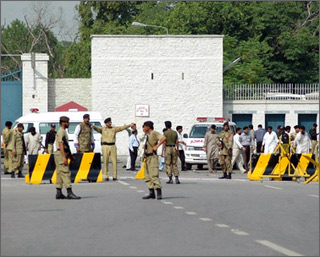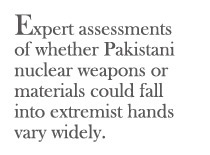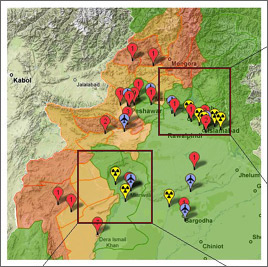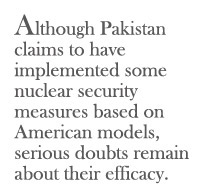Nuclear Challenge from Pakistan and Iran – Part I
Nuclear Challenge from Pakistan and Iran – Part I

WASHINGTON, DC: Pakistani Taliban leader Baitullah Mehsud’s death in August may have been a setback for militants in northwest Pakistan, but it was at best a temporary one. Decapitating the leadership of a militant organization is a notoriously poor way to address the grievances that feed extremism. Despite Mehsud’s death, the threat of militants attacking or infiltrating Pakistan’s nuclear program may be as great as ever. A recent report published by the Combating Terrorism Center at West Point in July revealed that in the past three years, terrorists have staged a series of dramatic attacks specifically targeting sensitive Pakistani nuclear facilities. In June, Afghan Al Qaeda leader Mustafa Abu al-Yazid said the group would seek to capture Pakistani nuclear arms to use against America. With the will and ability of extremists to target Pakistan’s most sensitive nuclear sites all but certain, the key questions are, how likely is it that these groups might actually get their hands on nuclear material, and how can that likelihood be decreased?

Expert assessments of whether Pakistani nuclear weapons or materials could fall into extremist hands vary widely, but most have been based on the same broad set of concerns about political instability and inadequate nuclear security. In a recent piece for Arms Control Today, Rolf Mowatt-Larssen, former head of the CIA’s terrorism efforts, cites the simultaneous growth of extremism, instability and the Pakistani nuclear arsenal itself as “worrying trends” that may compromise the army’s ability to maintain control of its nuclear material. Even Woodrow Wilson Center Fellow Hassan Feroz Khan, who argues that some Western fears about the safety of Pakistan’s nuclear arsenal are exaggerated, admits that the theft of nuclear material is a valid concern.
Add the strong possibility of conflict with India over Kashmir to Pakistan’s domestic risk factors and any crisis that threatened the state’s control would leave the rest of the world worrying whether Pakistan's nuclear weapons had fallen into extremist hands. In these very pages, Dr. Leonard Spector has argued that “once it was known that extremists had gained possession of the weapon-grade material, these groups could credibly claim to have a nuclear device.” In effect, once nuclear material is known to have fallen outside Pakistani government control, the world might be held hostage to the demands of any terrorist group in the region.
So just how likely is any of this to occur? Though imaginable, the likelihood of various nightmare scenarios is impossible to predict because these scenarios depend on unknown or classified information. However, public data can shed light on the chances the extremists could successfully assault or infiltrate a specific nuclear facility, and on what they might find there.

Calculating the risk of such an assault requires several types of data, including the locations of materials (plutonium and highly enriched uranium), the areas under extremist control, and the areas most vulnerable to large-scale attack. To synthesize this data, we have created an interactive Pakistani nuclear security map. In green shading, the map shows which areas of northwest Pakistan are under government control and, in red and orange, which are controlled or influenced by militants. Red markers indicate the sites of terrorist attacks this year, giving an idea of the militants’ ability to strike outside of areas they control. Yellow markers pinpoint the locations of suspected nuclear facilities and include information on what technology is located at each facility. Finally, blue markers are airbases where nuclear weapons may be deployed.
The map reveals that the most threatened nuclear facilities are those at Chashma-Kundian, near Mianwali in the center of the map, and the Wah Cantonment northwest of the capital, Islamabad. Chashma-Kundian is the site of two reactors and likely a reprocessing facility that produces weapons grade plutonium. It is only about twenty kilometers from districts with a Taliban presence. Wah is less than sixty kilometers from Taliban-controlled areas, and is likely one of Pakistan’s main nuclear weapons assembly facilities. An attack on any of those sites might net extremists enough nuclear material for a bomb – and Wah has already suffered multiple suicide bombings.

So how can these vulnerable sites be made more secure? Consider the valuable lessons from the Cooperative Threat Reduction (CTR) program, also known as Nunn-Lugar, under which the US and Russia dismantled thousands of nuclear warheads and secured tons of nuclear material at the end of the Cold War. Like Russia in the 1990’s, Pakistan is a relatively poor country with a fragile political system, located in an unstable region. To address these risks, CTR provided expertise and funding to upgrade security at nuclear facilities, including better screening of personnel. Over the longer term, the program set up better tracking and protection for nuclear materials in transit, and ways to transition ex-weapons scientists into lucrative, peaceful research. CTR shows that greatly enhanced security is possible, assuming high levels of trust and strict verification between officials and experts on both sides. Achieving that level of cooperation with Pakistan will be very difficult.
Although Pakistan claims to have implemented some nuclear security measures based on American models, serious doubts remain about their efficacy. Experience from CTR suggests that the government’s commitment to a security blueprint is worth little without consistent monitoring and improvement of security measures on the ground. Unfortunately, Pakistan has proven unwilling to accept more intrusive American help or advice on nuclear security since US assistance embarrasses the government and stokes popular paranoia about Westerners seeking to control the country’s nuclear arsenal. And Pakistan has refused to accept any help if doing so will compromise the locations of its nuclear weapons or facilities, perpetuating a tenuous balance between secrecy and vulnerability.

To improve nuclear security through CTR-type cooperation, the US should seek to improve the overall relationship with Pakistan. Civilian casualties in ongoing US drone strikes against Taliban and Al Qaeda forces are a major source of anger in Pakistan and must be minimized. But the central challenge is to move beyond the US-India-Pakistan strategic triangle. To start, the US must persuade Islamabad that the Islamic militants, whom Pakistan has tacitly supported as a thorn in India’s side, are themselves the greatest threat to Pakistan’s national security. Given the risk of extremists compromising Pakistan’s nuclear program, the US, India and Pakistan share a basic interest in combating both terrorism and proliferation.
Cooperation against this shared threat must begin with steps by Pakistan to dismantle Lashkar-e-Taiba, the group responsible for last year’s three-day terror assault in Mumbai, and now a symbol to many Indians of Pakistan’s ill will. A concerted US effort to reopen talks on Kashmir could also build trust by fulfilling what Pakistanis believe was an Obama campaign promise, while lowering tensions with India. Obama envoy Richard Holbrooke has so far refused to broach the Kashmir issue because of the strong Indian objection to a US role. But without publicizing such talks, the US should find ways to promote dialogue between the two countries.
Without more active US help, Pakistan’s nuclear facilities will remain unacceptably vulnerable to terrorist assault or infiltration, particularly in key locations where a growing nuclear program and the ongoing, widespread Islamist insurgency intersect. Although the Pakistani Taliban may be momentarily weakened, the broader risk to Pakistan’s nuclear arsenal remains. Real “cooperative threat reduction” in Pakistan must place greater emphasis on cooperation, trust-building, and a broader regional security dialogue that includes India.
Matthew Rojansky is Executive Director of the Partnership for a Secure America (PSA), a group founded by senior Democrats and Republicans to restore the bipartisan center in US national security and foreign policy. Daniel Cassman served as a research assistant at PSA.